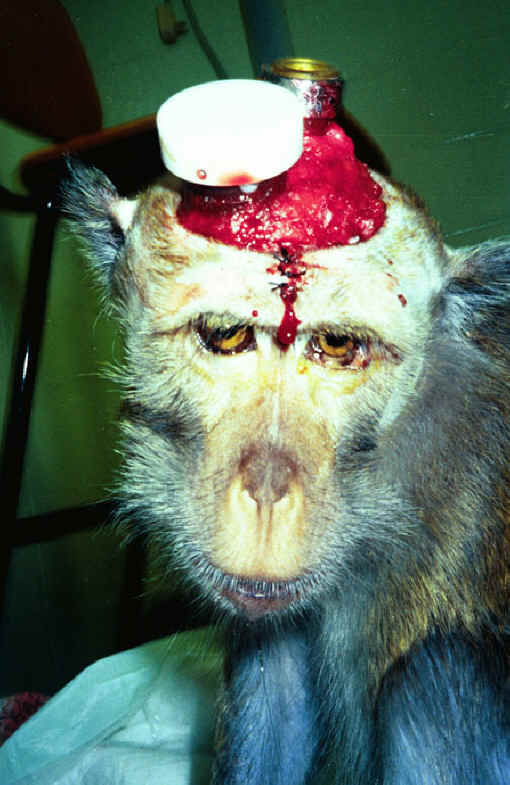
Once again academics expose themselves as apologists for torturing our relatives; primates. Report backs use of monkeys in research
"There is a scientific case for careful, meticulously regulated non-human primate research, at least for the foreseeable future, provided it is the only way of solving important scientific or medical questions," says inquiry chairman David Weatherall of the University of Oxford.
Hmm wonder what would happen if we replaced non-human primate with human in this statement.
"There is a scientific case for careful, meticulously regulated human research, at least for the foreseeable future, provided it is the only way of solving important scientific or medical questions,"
Yep seems justifiable to me to continue to experiment on humans, after all there are more of us than there are dwindling species of endangered primates. However despite the reports glossing over the issue of torture, its not like they are only experimenting on just a few of our cousins.
Who are imprisoned in cages for the rest of their short lives.
 Captive rhesus macaques are not naturally aggressive, but poor husbandry and handling practices can trigger their aggression toward conspecifics and toward the human handler. The myth of the aggressive monkey probably is based on often not taking into account basic ethological principles when managing rhesus macaques in the research laboratory setting.
Captive rhesus macaques are not naturally aggressive, but poor husbandry and handling practices can trigger their aggression toward conspecifics and toward the human handler. The myth of the aggressive monkey probably is based on often not taking into account basic ethological principles when managing rhesus macaques in the research laboratory setting. Macaca mulatta is the most common nonhuman primate species found in biomedical research facilities in the United States. Of the 57,000 or so primates (United States Department of Agriculture, 2000), approximately 33,000 (58%) animals are rhesus macaques (National Center for Research Resources, 2002) of whom an estimated 16,500 (50%) are living in cages.
After all how many humans would not voluteer for this experiment. What You can learn from drunk monkeys
And it is going to be 'meticulously regulated' research so it should be non leathal and perfectly safe. Not.
Of course most of us would not volunteer to really be put in this monkeys place no matter how meticulous the regulations......

Monkeys Tortured with Shocks Humans Found UnbearableIn the 50's and 60's, much work on "pain centers" and "pleasure centers" in the brain was carried out at Yale by José Delgado, a picaresque neuropsychologist who would like to see "human society 'psychocivilized' through brain stimulation and other influencing techniques." (Lausch, E.,1972, p. 121). Some of his experiments involved electroshocking monkeys in brain areas known to produce intense pain. (Delgado, J.,1966).
An idea of the pain suffered by these monkeys may be obtained by comparison with experiments in which the same brain areas were stimulated in man by B. Nashold and other neurosurgeons. The surgeons implanted electrodes in patients in the course of operations and recorded the sensations reported by the latter during electrical stimulation. In the area of the central gray matter at the level of the superior colliculus in the midbrain, stimulation produced bodily sensations of pain, burning, vibration and cold. In addition, a patient would experience feelings which were "described as 'fearful,' 'frightful,' or 'terrible,' and he would become apprehensive and not allow further stimulations." (Nashold, B., 1969).
Delgado implanted an electrode in the same place (the central gray area near the superior colliculus) in the brain of a rhesus monkey named "Harry." First, with the monkey in restraint, 1.2 milliampere shocks were given. Harry tried to grab anything in reach, bit the chair after every shock, then, released into a small cage, bit the swing as the shocks continued, attacked other monkeys, and finally climbed the wall and clung there.
Although humans, once they had experienced it, could not stand a second stimulation in this brain area, Harry was subjected to 40 minutes of intermittent shocks and 2 minutes of continuous shocks. Other monkeys shocked in the same area responded with screams, grimaces and "signs of aggressiveness directed against the investigator." Through multiple electrodes implanted in their brains, Delgado tested various areas known to cause offensive-defensive reaction when stimulated, and over a period of two days he subjected the monkeys to more than 120 stimulations at each cerebral point, after which they were killed and autopsied.
Although he proposes a hypothesis that brain mechanisms for perception of pain and aggressive behavior have different anatomical and physiological systems, he admits that the evoked aggression was often secondary to electrical excitation of the pain pathways, and that the monkeys demonstrated this by their screams ("high-pitched vocalizations"), dilated pupils, snarling expressions and efforts to escape.
Delgado's experiments were then used on humans to change behaviour, including their use on depressed women and homosexuals. It was used to torture political prisoners under the care of the CIA and their client states in Latin America. Of course under 'meticulous regulations'.
See
Primates
Monkeys
Great Apes
Organutan
Find blog posts, photos, events and more off-site about:
primates, labs, laboratory, vivesection, animalrights, monkeys, rehsus monkey, Macaca mulatta , apes, monkeys, science, torture, agression, mammals, chimps, chimpanzess, experiments, CIA, Jose Delgado,
No comments:
Post a Comment